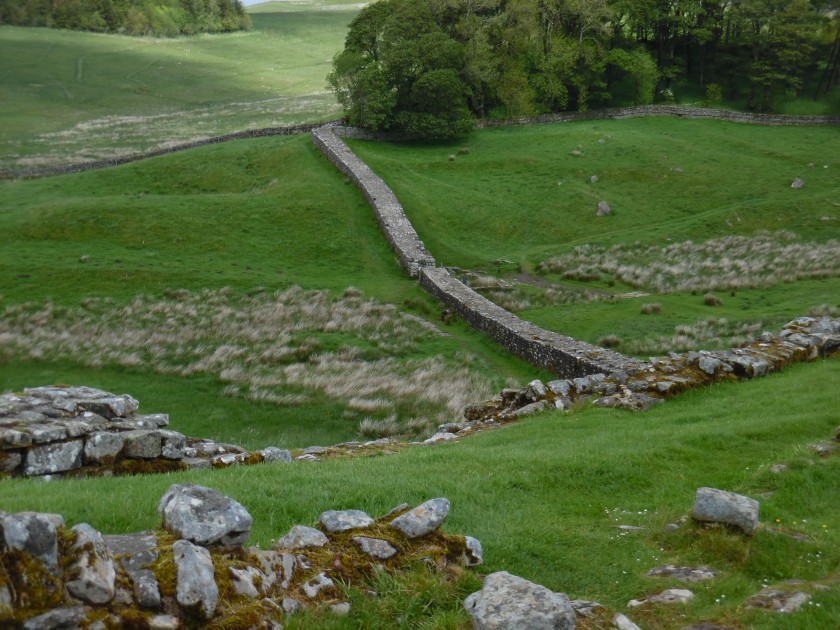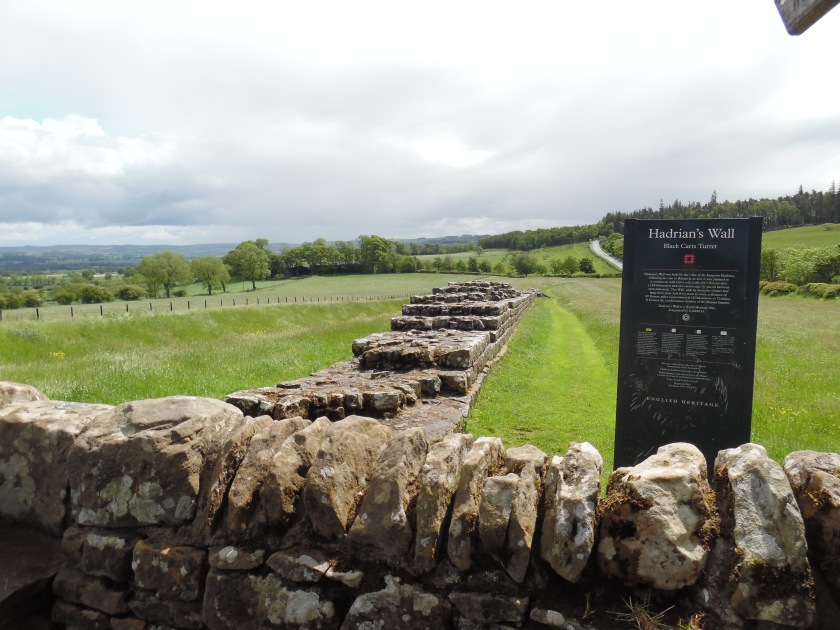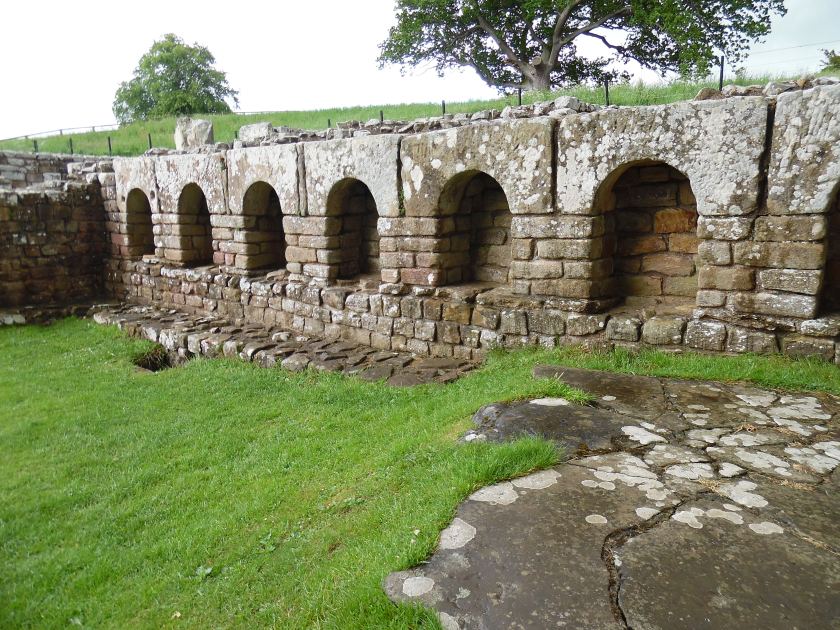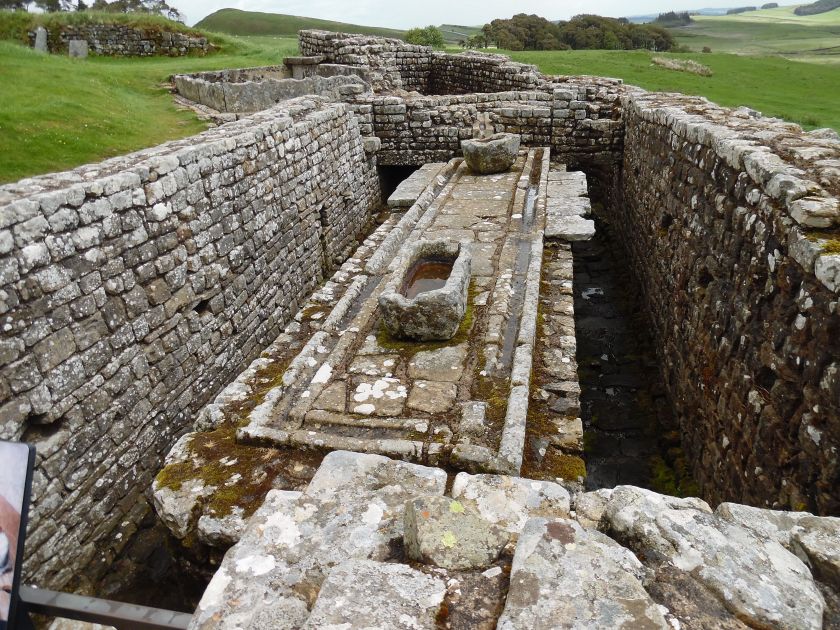
Throughout history, great empires have built walls for many different reasons. Some were meant to keep people in (the Berlin Wall- built in 1961 and torn down in 1991). Others kept people out (The Great Wall in China, built over several centuries and still standing in places).The wall I’d like to talk about here is Hadrian’s Wall, built on the Roman frontier in the second century, CE.
Hadrian’s Wall was an engineering marvel. It stretches 73 miles from coast to coast across the England. The first plan called for 80 milecastles with two stone watch towers or turrets between each pair and a gate at each milecastle. This plan changed so that in addition to the milecastles, but instead of a gate at each one, seventeen larger forts were eventually built along the wall, and a large ditch was constructed south of the wall. This effectively reduced the number of places troops could go through the wall to the north, or northern traders could cross the wall toward the south. The gates were double wide, allowing for greater mobility for the Roman Army.
This change helps us understand some of the purposes for the wall. Though it served as a effective barrier against some of the northern Pictish tribes, the wall was not primarily for defense. This can be seen by the fact that the doors on the turrets were at ground level. In fact, it seems the primary purpose of the wall was economic. Rome wanted to control (and tax) trade into and out of their empire. The wall, some 6-10 feet wide and 11- 20 feet tall, built mostly of stone, was probably covered in plaster and white-washed. It served as a stunning monument to Rome’s power and reach. “Here begins civilization!” the wall seemed to proclaim. All who would enter, must accept Rome’s control, and pay Rome’s taxes.
I explored the length of Hadrian’s Wall on Midsummer’s Day in 2015. We had rain showers off and on all day, with brilliant sunshine in between. In spite of the sun, the day felt cold and damp, with a brisk wind. It was easy to imagine the poor Roman soldier, posted to this far-flung wilderness, at the edge of the empire.

Our first stop along the wall was at Chester’s Fort. Here I was particularly impressed with the baths. Public baths were common throughout the Roman empire, and a sign of their advanced civilization. The baths had a warm room, a hot room, and cool room. Water for the baths was heated and and distributed to the proper area through a ‘hypocaust’ system, (underfloor heating).

The next stop along the wall was Housesteads, an iconic Roman fort built high on a ridge with a commanding view of the entire valley below. Housesteads was one of the later forts built along the wall. One of the marvels here is the Roman ‘modern’ latrine with running water. In spite of this mark of civilization, Housesteads was still far from the center of the Empire. A rough, crime-filled frontier town (Vicum) grew up outside the fort. Here, for nearly three centuries, Romans and Britons mingled, traded, and squabled, with the Roman legion nearby to keep the peace.

Next we stopped at Birdoswald, which was occupied until the early 5th century. This area of the wall was originally built primarily of turf, though later sections were rebuilt in stone. The Roman soldiers here in the 3rd and 4th centuries were mostly from a regiment raised in what is now Romania, far east along the northern border of the vast Roman Empire.

The last place we visited along the wall was Lanercost Priory, built around 1169, centuries after the Romans had retreated. The place is significant partly because the builders used many stones from the abandoned wall to build this priory. Roman maker

marks, games, and inscriptions can be seen in the stones used to build the walls. In all those years since Rome dominated the area, Lanercost still stood in the borderlands between England and Scotland. The priory suffered many raids, as well as serving as a meeting place for King Edward III of England and King Robert Bruce of Scotland. By 1369, the priory was bankrupt. In the following centuries as the borders between England and Scotland shifted back and forth, the priory fell into ruin.
Hadrian’s Wall was one of several the Romans built to control their borders. It seems that no matter how great Rome became or how far their empire stretched, there was always trouble at the borders. Though impressive in the their remains, none of the great walls built by great empires have been entirely successful. The Berlin Wall was torn down after only 30 years. Enemy tribes invaded China from the north and took over the country. Hadrian’s wall, so far from the center of Rome, was abandoned and neglected as Rome’s power shrank.

Even more than protecting an empire’s interests, walls serve to separate people. But people do not always want to be separated from neighbors, family, friends, and business partners. In the end, walls will be breached, their stark ruins reminding us of the fallen empires who built them.

It is to be hoped that future people will not see the stupid trump border wall as the failed ruin of a fallen civilization!
LikeLike
I’ll second that. It is always wise to look at history when trying to understand the present.
LikeLike